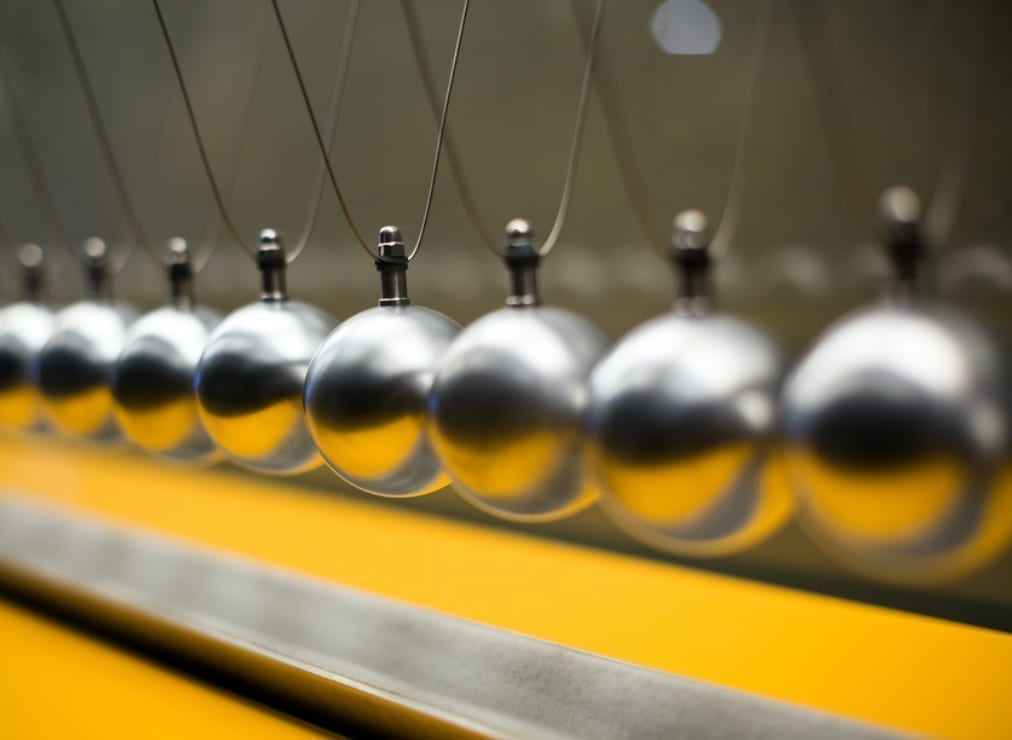A telescope collects more light than a dilated pupil of the eye can gather and focuses it on the retina. As lenses improved, it became evident that chromatic aberration was going to put a limit to how far we could progress with lenses – the bigger the lenses became, the more they acted like prisms , splitting different colours apart and producing a blurred image. Achromatic lenses partly corrected for this, combining different types of glass in layers with one partly correcting the aberration produced by the other. Ultimately, mirrors took over from lenses as the focusing mechanisms.
Mirrors have shallow surfaces and there is no chromatic aberration. Therefore, when mirrors improved in quality, new still larger telescopes could be built and astonishing images of the far reaches of space could be obtained.
Thus, in his newly-released book “Awesome Creation”, Rabbi Yosef Biton relates how, in 1923, Edwin Hubble was able to discover the first galaxy outside our own. This rapidly led to more and more galaxies being discovered and it was evident that they are all racing apart from each other at a fantastic pace. This led to the Big Bang theory – science had proof of a Beginning.
After many centuries of attempting to avoid the concept of a Creator by theorising that the universe had always existed, they had in essence come to agree with the Torah concept of a Creation. Yet some scientists chose to conveniently divert the ‘debate’ into a new direction – the issue of estimation of the timespan since this Big Bang.
It is no exaggeration to say that mirrors, in a sense, enabled science to potentially move much closer to Torah. Mirrors gave us a closer look at the Heavens and enabled mankind to visually appreciate the true magnificence of the Creation. They even offered sceptics an opportunity to admit to the veracity of our Torah’s very first teaching – that of a Creation.
However, even for those who are already in tune with the Torah’s teachings, contemplation of mirrors and what they do may help to unravel some of the mysteries of our own Mesora as given over by Chazal. Just as the Physical Universe is clarified and magnified through the medium of mirrors, we may find that we are able to better fathom some of our Spiritual Universe, the Torah’s messages, more accurately, only if we reflect on the role of mirrors and their secrets.
Let’s start with a mysterious discovery which scientists made only four years ago. Giovanni Caputo set up multiple mirrors to study how people confront multiple reflections of themselves. By chance, he once entered this research room early one morning in semi-darkness. He looked at himself for some time in a mirror and soon saw strange phenomena, unusual things appearing and ‘happening’ in the mirror. He tested it on the other participants in the research group and it happened to them as well.
The phenomena included their own eyes seeming to move, the nose enlarging and mouth opening. Later-on the face seemed to be aging or changing dramatically and even a different face or animal figures appeared. He found this also happened with anyone else who tried this in low light conditions. (Reed Business Information, 2013, reprinted in Popular Mechanics). The researchers do acknowledge that this phenomenon may have been known before in folk-lore, and that hallucinations induced by reflections may have been known for thousands of years, but they assume that the phenomenon was never established scientifically.
Let us return to the more ‘mundane’ aspects of mirrors. Assume that we are aware of a basic fascinating fact: when you look at yourself in a mirror, your left hand is facing your left hand and the right reflects in line with the right hand; yet when you are facing someone else, their left hand is opposite your right hand and vice versa. Well, it may strike us that we are onto something interesting.
Incidentally, we also hear ourselves differently from the way anyone else hears us. We hear ourselves by both air conduction (our own voice travelling to our ear drums through the air), and bone conduction (our vocal cord vibrations travelling directly inwards via the bone structure of the skull towards our hearing apparatus). Others hear us only via air conduction. So we both see and hear ourselves differently from the way anyone else does. There seem to be clear physical parallels here to our concept of being ‘nogeah’ – being biased somehow in the way we see others vs. the way we see or relate to ourselves.
It was thus astonishing to find what no less a personage than R’ Chaim Mivolozhin had in fact synthesized this observation. The Pardes Yosef, in the section on Parshas Toldos, pg. 504, quotes R’ Chaim as follows (paraphrased translation): it is the nature of people to play down the virtues of their fellow man and to magnify their shortcomings…. We see this represented in the fact that when one stands facing someone else, his right hand projects opposite the left of the other and vice versa. This alludes to the fact that he pays strong attention to the weak points of his fellow and pays weak attention to the virtues of his fellow!
However, when he looks into a mirror, he sees himself right facing right and left facing left – this is indeed what the posuk means in Mishlei (27:19) ‘ kemayim haponim leponim, kein leiv ha-odom le-odom’ ( A basic translation would be ‘As water reflects a face back to a face, so one’s heart is reflected back to him by another’ , but R’ Chaim Mivolozhin is teaching us that we can translate it slightly differently too – that we have to train ourselves to feel sincerely and without bias towards our fellow the way we feel towards ourselves – just as we see our true reflection in water, without distortion and inversion, so (should) our hearts be to one another.
What a great achievement that would be – to look only at the good in others. If we take this lesson of R’ Chaim to heart, perhaps we can apply his concept to help to unravel two puzzling episodes related in the Medrash and quoted by Rashi on Chumash.
When Avraham and Sarah are about to enter Mitzrayim, Parshas Lech Lecho tells us that Avraham says to Sarah (12:11-13) ‘Behold, now I have known that you are a beautiful woman…. ‘ and he fears for his life and what may happen to Sarah. Rashi relates the comment of the Medrash: they had to cross a river on the way into Mitzrayim. Avraham looked down and saw the reflection of Sarah on the surface of the water. In response to this he said ‘now I know (literally ‘knew’ – ‘hinei noh yodati’) that you are a beautiful woman….’.
Perhaps this means to say ‘now I know- I knew but did not so fully appreciate until now’. Having travelled through other cultures and seen their low value systems and being on the verge of entering the utterly degenerate land of Mitzraim, Avraham is struck by the extreme danger of exposing the physically and spiritually magnificently beautiful Sarah to the Egyptian environment and people.
Furthermore, it would seem strange indeed for them to see each other now for the first time and for them to have married without the requirement being fulfilled of the husband having to see the wife beforehand. So , applying the concept of R’ Chaim, it seems that we could say that what Rashi and the Medrash are telling us is as follows – the description of Avraham, looking at Sarah in the water, symbolises that he looks at her now for the first time fully appreciating her true perfection – with no distortions, no misperceptions.
Just as one looks at himself in a mirror and does not have distorted perception of himself, so too, here Avraham, next to Sarah, is looking at her in a reflection and this gives an even more genuine appreciation than looking at the person directly – seeing the other as you look at yourself! He is totally struck by her lack of any imperfection. He appreciates her to the fullest extent now for the first time. Possibly the solitude of the journey here, with ‘’kiruv rechokim’’, the opposition to child sacrifice and other such issues put aside for now, also facilitated Avraham Avinu’s focus on Sarah totally for the first time. To me it seems fascinating that this focus is again described in terms of seeing her in a ‘’mirror’’, in a reflection, on the surface of the river which they are crossing.
There is clearly a two-sided aspect here – we see from the above cases, with Reb Chaim Mivolozhin’s insight, that in certain aspects, mirrors give a more accurate and unbiased view of others. However, we stated already in discussing the mystery of mirrors, that in various ways mirrors are also filled with illusion and, as we said before, “a mirror…. simulates the sense impressions of things that really aren’t “there”. Notice that mirrors are among the few objects on which we almost never focus our eyes……”. So mirrors are very accurate for some purposes (after all, which artist can draw an image as accurate as one reflected by a mirror?) and yet are misleading in other ways!
In Vayakel, we learn about how the women were in the forefront in giving towards the Mishkan. This is all the more amazing as the Mishkan was at least in part an atonement for the Eigel– which the women were not guilty of participating in. Then the posuk (38:8) tells us that …He (Betzalel) made the kiyor, the copper washbasin, out of the mirrors of the women who were ‘tzovos’ , congregated at the entrance of the OhelMoed.
Rashi quotes the Medrash Tanchuma, which is found in Pikudei 10 ( and the story is also brought in various other midrashim aswell as in the Gemoro Sota 11b), to explain that when the women wanted to donate the mirrors, Moshe Rabeinu was going to reject them because they seem to be associated only with sensuality. Hashem, however, told Moshe to definitely accept them, ‘because these are the most cherished to Me of all!’ The reason, explained Hashem, was that they represented the way the Noshim Tzidkoniyos of Klal Yisroel had guaranteed the future of the Klal Yisroel – somehow the mirrors were intrinsic to the way they did it.
The accounts given are that when the women would go to draw water, Hashem would provide small fish in their jugs. They would cook some, sell some to buy wine, and go to the fields to feed their husbands. They would give their husbands something to eat and drink, make them feel better after the back-breaking, soul-destroying labour and then each woman would hold up her mirror and the couple would look at each other in the mirror and then wife would say ‘am I not more beautiful than you?’ and (according to the recent Zichron Aharon edn. based on thorough study of original manuscripts) the husband would say the same to his wife!…and she would then conceive….’under the apple tree I aroused you’ (Shir Hashirim 8:5).
Now it would surely have been more straightforward to simply say that the women donated the mirrors with which they adorned themselves to help to encourage their husbands to continue with normal marital life – why do all the sources on this mention the phenomenon of the women holding up the mirrors so that the couple could sit together see each other in this strange way – even more strange because this apparently was done by all of them! This has to be acknowledged to be a very unusual way even for one couple to utilise a mirror – let alone all of the couples!
Furthermore, for each one to tease the other and say ‘am I not more beautiful than you?’ is also an unusual aspect – if only the wife said this it would be more comprehensible. Thus, based on the observation of R’ Chaim Mivolozhin, we can say firstly, they had clearly reached a new level of appreciation of each other and could find no fault in one another at all, no distortions or critical attitudes.
Secondly, perhaps indeed part of what Chazal want to point out is that the women were so highly successful in rejuvenating the husbands and giving them renewed hope – this is represented in the fact that, when they made the light-hearted remarks about being more beautiful than the men, the men had recovered to the extent that they could in turn tease the women and say that they were in fact the more beautiful ones!
[Basically it seems this Medrash is telling us that, since the men were not interested in normative life issues, the women pretended to have the mirrors there to titivate themselves. They then grabbed the moment to move the mirrors over a little and let the husbands, who were not in a mood to even look even at them, see them. They then made the remark ‘’am I not more beautiful then you?’’ etc. and so opened the way to attract and rejuvenate their husbands. The scenario thus unfolds to a situation where they are seeing each other in a mirror, and this is the aspect which lends itself to the above insight or suggestion about the unique feature of looking together into a mirror] .
We learn, as stated by Rashi and the Medrash, that Moshe Rabeinu felt that the mirrors purely represented the sensual and were thus simply not suitable. Hashem responded that they were indeed suitable – that the Yetser Horah, when harnessed correctly, can be utilised to achieve holy purposes.
Perhaps the Medrash contains another element as well. It also still seems a little surprising that Moshe Rabeinu did not somehow try to accommodate their gift of the mirrors – especially as the women had not participated in the Eigel and did not need the kaporo for that – it was such a forthcoming gesture to bring the mirrors.
There is a vast gap between Moshe Rabeinu’s impression and what Hashem said to him–‘Moshe, do not despise these mirrors. Take them and make the copper kiyor….and from it the Cohanim will sanctify themselves’. So Hashem told Moshe Rabeinu to definitely accept this gift and that it is of the highest order of Kedusha. Is it not strange to find such a huge gap? Now this may no longer be such a puzzle if we take this understanding of the mirror episode into account. The mirror episode was a private interlude which the couples each shared. Moshe Rabeinu would not have known of this yet.
Furthermore, the mirrors did not simply act here in their classic role of sensuality – their other or perhaps main role, as we have deduced, was to establish and represent the phenomenal level of Shalom Bayis which was achieved. It is this which also made them eminently suitable as the gateway, in a sense, to all Avoida, to all Kedusha. Hashem knew this, but Moshe Rabeinu did not know of this yet. Hashem simply had to instruct Moshe to definitely accept them – they were involved in the way the women ensured the survival of the hosts of KlalYisroel in Mitzraim and they were now to become a preparation for and a key part of the holiest service in the Mishkan. Rashi quotes the first part of this Medrash Tanchuma about the mirrors, but Rashi there in his peirush on Chumash, as is often the case, does not quote the entire Medrash.
It is this same Medrash which in fact goes on to tell us another key fact aswell – that the mirrors became the structure of the Laver (the Kiyor), and how the Cohanim would sanctify their hands with the water from this Kiyor for every avoida.
Rav S.R. Hirsch in fact says the mirrors were even kept in their whole state and put together to form the kiyor. In addition, commentaries point out that, whereas other contributions were limited and stopped once the quota was reached, here all of them were accepted. They certainly represented an unmatched level of Kedusha. How so? As we stated above, based on what we learned and extrapolated from R’ Chaim Mivolozhin, it seems clear we can say that the imagery of each couple looking together into the wife’s mirror represents the fact that the couples reached a state of absolute harmony – they saw each other without faults, without distortion.
This then is probably the highest level of Shalom Bayis ever achieved in KlalYisroel and it was achieved under such trying circumstances! It is no longer a surprise then, that these mirrors deserve a place in preparation for the Holiest of service – it was an epoch of collective Shalom Bayis which in fact guaranteed the future of KlalYisroel.
Just as Ke-ish Echod U-be-leiv Echod later was the key to Kabolas Hatorah as a Nation, so too this amazing level of universal Shalom Bayis in each and every couple was the key to Klal Yisroel’s survival – it generated a level of collective, simultaneous merit which Hashem looked upon and rewarded with the very continuation of Klal Yisroel, both physically and spiritually.
Gilbert Bou Jaoudé, médecin sexologue. Votre adresse de messagerie ne sera pas publiée. cialispascherfr24.com Enregistrer mon nom, mon e-mail et mon site web dans le navigateur pour mon prochain commentaire.





